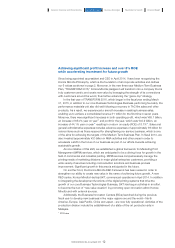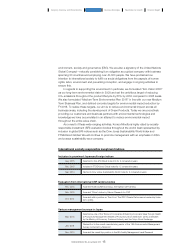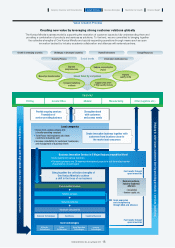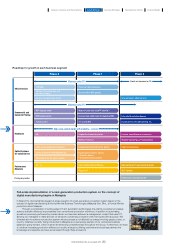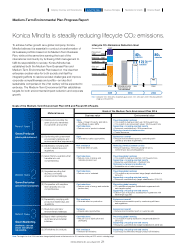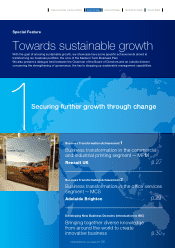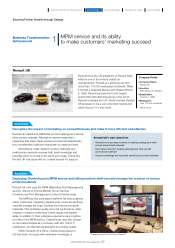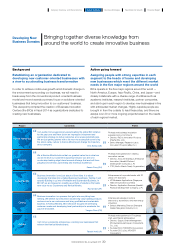Konica Minolta 2015 Annual Report Download - page 22
Download and view the complete annual report
Please find page 22 of the 2015 Konica Minolta annual report below. You can navigate through the pages in the report by either clicking on the pages listed below, or by using the keyword search tool below to find specific information within the annual report.
Procurement
stage 352
Product use 1,137
Production 387
Sales and
service 93
Distribution 58
(thousand tons)
Lifecycle CO2 Emissions Reduction Goal
2,027
Actual VisionEstimated emissions
when measures are
not implemented
Goal
1,388
1,216
405
Note: Lifecycle CO2 emissions reduction goal covers CO2 emissions from the procurement
stage as of fiscal 2014.
Goals of the Medium-Term Environment Plan 2016 and Fiscal 2014 Results
Green Products
(planning and development)
Material Theme
1
Green Factories
(procurement and production)
Material Theme 2
Green Marketing
(distribution, sales and
service, and collection
and recycling)
Material Theme 3
Material issues Goals of the Medium-Term Environment Plan 2016
Business value Environmental value
Sales
• Sales of Green Products: 640 billion
yen (Share of sales: 58%)
Cost reductions
• Reduce cost of product materials
Preventing global warming
• CO2 reduction during product use: 59 thousand tons
• CO2 reduction at procurement stage: 105 thousand tons
Supporting a recycling-oriented society
• Resources used effectively: 33 thousand tons
Reducing chemical substance risks
• Control emissions
(1) Creating and providing the
green products demanded
by customers and society
Cost reductions
• Reduce costs of energy and
materials (reduce loss)
Preventing global warming
• CO2 reduction during production: 9.2 thousand tons
Supporting a recycling-oriented society
• Resources used effectively: 4 hundred tons
Restoring and preserving biodiversity
• Sustainable use of water resources
(1) Green Factory operations that
translate into cost
competitiveness
Net sales
• Acquire sales opportunities
Environment overall
• Reduce environmental impact on customer side
(1) Resolving customers’
environmental challenges
Sales
• Eliminate lost sales opportunities
Environment overall
• Reduce environmental impact by conforming with
standards and label requirements
(2) Conforming with government
procurement standards and
environmental label requirements
Risk avoidance
• Eliminate effect on sales
Reducing chemical substance risks
• Reduce hazardous chemical substance risk by
conforming to laws and regulations
(3) Dependably complying with
product-related laws and
regulations
Cost reductions
• Reduce costs of energy and materials
(reduce loss)
Preventing global warming
• CO2 reduction at suppliers (established in agreement with
each target supplier)
Supporting a recycling-oriented society
• Effective use of resources (established in agreement with
each target supplier)
(3) Cooperation with suppliers
that translates into cost
competitiveness
Cost reductions
• Reduce cost of distribution and
packaging
Preventing global warming
• CO2 reduction during distribution: (target established in
2015 Q2)
Supporting a recycling-oriented society
• Resources used effectively: (target established in 2015 Q2)
(2) Supply chain optimization
and linked environmental
initiatives
Risk avoidance
• Reinforce 3R initiatives
Supporting a recycling-oriented society
• Use resources effectively through product 3R initiatives
(3) 3R initiatives for products
Risk avoidance
• Eliminate effect on production
Environment overall
• Reduce environmental impact by conforming with laws
and regulations
(4) Dependably complying with
production-related laws and
regulations
Cost reductions
• Reduce cost of materials
Preventing global warming
• CO2 reduction at procurement stage (target established in
2015 Q1)
Supporting a recycling-oriented society
• Resources used effectively (target established in 2015 Q1)
(2) Upgraded recycling that
resolves community
environmental challenges
Note:
The targets for fiscal 2016 have been changed partially based on the forecast of a 40% reduction in lifecycle CO2, which is a binding target.
2005 20502016
40%
reduction
172
reduction
thousand
tons
80%
reduction
Medium-Term Environmental Plan Progress Report
Konica Minolta is steadily reducing lifecycle CO2 emissions.
To achieve further growth as a global company, Konica
Minolta believes it is essential to conduct a transformation of
its business portfolio based on its Medium Term Business
Plan, while at the same time earning the trust of the
international community by furthering CSR management to
fulfill its responsibility to society. Konica Minolta has
established both the Medium Term Business Plan and
Medium-Term Environmental Plan based on the idea that
enterprise creates value for both society and itself by
integrating efforts to resolve societal challenges and improve
corporate competitiveness and profits—an idea that
sustainable companies in the 21st century will be expected to
embrace. The Medium-Term Environmental Plan establishes
targets for both environmental impact reduction and corporate
growth.
21
KONICA MINOLTA, INC. Annual Report 2015
Foundation for GrowthBusiness StrategiesGrowth StrategyCompany Overview and Characteristics Financial Report



